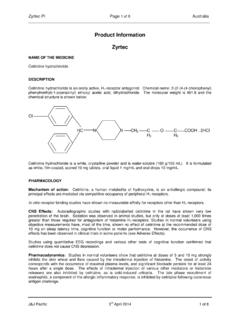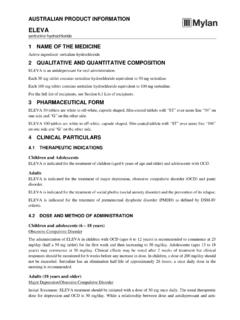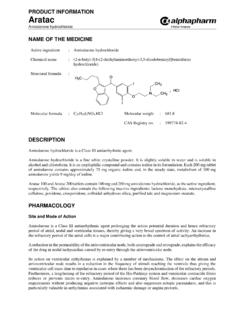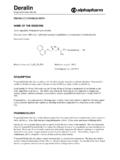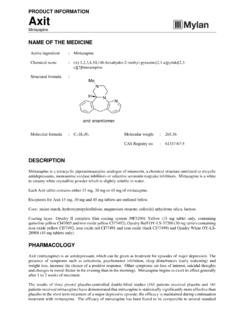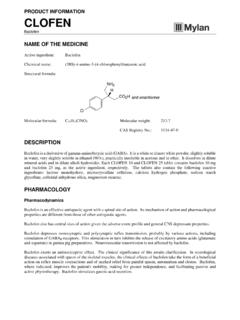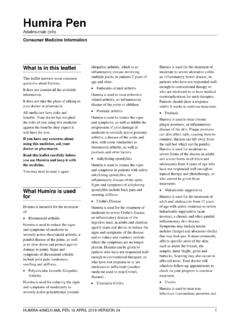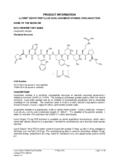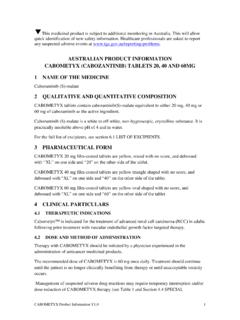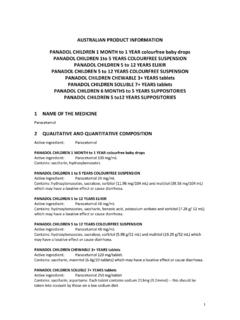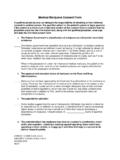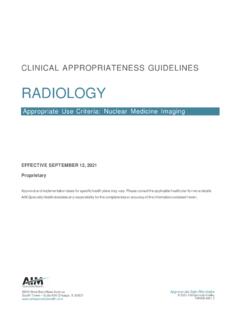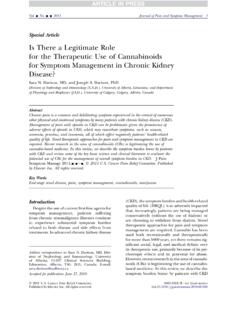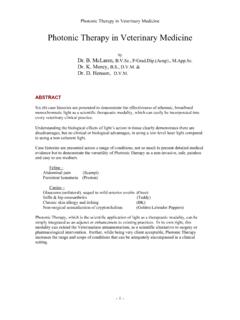Transcription of 1 NAME OF THE MEDICINE 2 QUALITATIVE AND …
1 MAVIRET PI Version 6 19 March 2020 Page 1 of 32 This medicinal product is subject to additional monitoring in Australia. This will allow quick identification of new safety information. Healthcare professionals are asked to report any suspected adverse events at AUSTRALIAN PI MAVIRET (glecaprevir / pibrentasvir) tablets 1 NAME OF THE MEDICINE Glecaprevir and pibrentasvir 2 QUALITATIVE AND QUANTITATIVE COMPOSITION MAVIRET is a fixed-dose combination tablet containing glecaprevir 100 mg and pibrentasvir 40 mg. The tablets do not contain gluten. The tablets contain lactose. For the full list of excipients, see LIST OF EXCIPIENTS. Glecaprevir is a white to off-white crystalline powder with a solubility of less than to mg/mL across a pH range of 2 7 at 37 C and is practically insoluble in water, but is sparingly soluble in ethanol. Pibrentasvir is a white to off-white to light yellow crystalline powder with a solubility of less than mg/mL across a pH range of 1-7 at 37 C and is practically insoluble in water, but is freely soluble in ethanol.
2 3 PHARMACEUTICAL FORM Glecaprevir and pibrentasvir are presented as co-formulated, film-coated, immediate release tablets. The tablet strength is 100 mg glecaprevir (anhydrous) and 40 mg pibrentasvir. 4 CLINICAL PARTICULARS Therapeutic indications MAVIRET is indicated for the treatment of adult and adolescent patients12 years and older with chronic hepatitis C virus (HCV) genotype (GT) 1, 2, 3, 4, 5, or 6 infection with or without compensated cirrhosis. This includes patients with HCV GT1 infection who were previously treated with either a regimen of an NS5A inhibitor or with an NS3/4A protease inhibitor but not both classes of inhibitors (see DOSE AND METHOD OF ADMINISTRATION and PHARMACODYNAMIC PROPERTIES Clinical trials). Dose and method of administration MAVIRET is a fixed-dose combination product containing glecaprevir 100 mg and pibrentasvir 40 mg in each tablet. MAVIRET PI Version 6 19 March 2020 Page 2 of 32 Recommended dosage in adults and adolescents (12 years and older) The recommended oral dosage of MAVIRET is three tablets (total daily dose: glecaprevir 300 mg and pibrentasvir 120 mg) once daily at the same time with food (see PHARMACODYNAMIC PROPERTIES).
3 MAVIRET tablets should be swallowed whole and not chewed, crushed, or broken. Tables 1 and 2 provide the recommended MAVIRET treatment duration based on the patient population in HCV mono-infected and HCV/HIV-1 coinfected patients with compensated liver disease (with or without cirrhosis) and with or without renal impairment (including patients receiving dialysis). Table 1. Recommended Duration for Treatment-Na ve Patients Patient Population Treatment Duration No Cirrhosis Compensated Cirrhosis (Child Pugh A) GT 1, 2, 3, 4, 5 or 6 8 weeks 12 weeks Table 2. Recommended Duration for Treatment-Experienced Patients Patient Population Treatment Duration No Cirrhosis Compensated Cirrhosis (Child Pugh A) GT 1, 2, 4, 5 or 6 PRS-experienced* 8 weeks 12 weeks GT 1 NS3/4A PI-experienced1# (NS5A inhibitor-na ve) 12 weeks GT 1 NS5A inhibitor experienced2# (NS3/4A PI-na ve) 16 weeks GT 3 PRS-experienced* * PRS = Prior treatment with regimens containing peginterferon (P), ribavirin (R), and/or sofosbuvir (S), but no prior treatment experience with an HCV NS3/4A PI or NS5A inhibitor 1 Experienced with regimens containing SMV + SOF or SMV + PR or BOC + PR or TVR + PR 2 Experienced with regimens containing DCV + SOF or DCV + PR or LDV + SOF or SOF + VEL # But not bothNS3/4A PI and NS5A experienced EBR + GZR RBV or PTV/r + OBV + DSV RBV MAVIRET PI Version 6 19 March 2020 Page 3 of 32 BOC = boceprevir; DCV = daclatasvir; DSV = dasabuvir; EBR = elbasvir; GT = genotype; GZR = grazoprevir; LDV = ledipasvir.
4 OBV = ombitasvir; PI = protease inhibitor; PR = peginterferon/ribavirin; PTV/r = paritaprevir/ritonavir; RBV = ribavirin; SMV = simeprevir; SOF = sofosbuvir; TVR = telaprevir; VEL = velpatasvir Hepatic Impairment No dose adjustment of MAVIRET is required in patients with mild hepatic impairment (Child-Pugh A). MAVIRET is not recommended in patients with moderate hepatic impairment (Child-Pugh B) and is contraindicated in patients with severe hepatic impairment (Child-Pugh C) (see CONTRAINDICATIONS, SPECIAL WARNINGS AND PRECAUTIONS FOR USE Use in Hepatic Impairment and PHARMACOKINETIC PROPERTIES Pharmacokinetics, Specific Populations, Renal Impairment). Renal Impairment No dose adjustment of MAVIRET is required in patients with any degree of renal impairment including patients on dialysis (see PHARMACOKINETIC PROPERTIES Pharmacokinetics, Specific Populations, Renal Impairment). Paediatric Use No dose adjustment of MAVIRET is required in adolescents 12 years and older (See PHARMACOLOGICAL PROPERTIES Clinical).
5 Geriatric Use No dose adjustment of MAVIRET is required in geriatric patients. In clinical studies of MAVIRET, 328 patients were age 65 years and over and 47 subjects were age 75 years and over. No overall differences in safety or effectiveness were observed between these patients and younger patients, and other reported clinical experience has not identified differences in responses between the geriatric and younger patients. Liver or Kidney Transplant Patients MAVIRET may be used for 12 weeks in liver or kidney transplant recipients. A 16-week treatment duration should be considered in GT1-infected patients who are NS5A inhibitor-experienced without prior treatment with an NS3/4A protease inhibitor or in GT3-infected patients who are PRS treatment experienced (PRS-TE) (see PHARMACODYNAMIC PROPERTIES Clinical Trials). Missed Dose In case a dose of MAVIRET is missed and it is: Less than 18 hours from the usual time that MAVIRET should have been taken, advise the patient to take the dose as soon as possible and then to take the next dose at the usual time; More than 18 hours has passed since MAVIRET should have been taken, advise the patient not to take the missed dose and to take the next dose at the usual time.
6 Patients should be instructed not to take a double dose. MAVIRET PI Version 6 19 March 2020 Page 4 of 32 Contraindications MAVIRET is contraindicated: In patients with severe hepatic impairment (Child-Pugh C) (see PHARMACOKINETIC PROPERTIES Pharmacokinetics, Specific Populations). With atazanavir containing products, atorvastatin, simvastatin, dabigatran etexilate, ethinyloestradiol-containing products, rifampicin (see PHARMACOKINETIC PROPERTIES Pharmacokinetics, Drug Interactions). Special warnings and precautions for use Risk of Hepatitis B Virus Reactivation Cases of Hepatitis B virus (HBV) reactivation, including fatal cases, have been reported during and after treatment of HCV with direct-acting antiviral agents in HCV/HBV co-infected patients. Screening for current or past HBV infection, including testing for HBV surface antigen (HBsAg) and HBV core antibody (anti-HBc), should be performed in all patients before initiation of treatment with MAVIRET.
7 Patients with serologic evidence of current or past HBV infection should be monitored and treated according to current clinical practice guidelines to manage potential HBV reactivation. Consider initiation of HBV antiviral therapy, if indicated. MAVIRET has not been studied in patients with HCV/HBV co-infection. Use in Hepatic Impairment MAVIRET is not recommended in patients with moderate hepatic impairment (Child-Pugh B) and is contraindicated in patients with severe hepatic impairment (Child-Pugh C) (see DOSE AND METHOD OF ADMINISTRATION, CONTRAINDICATIONS and PHARMACOKINETICS PROPERTIES). potential Effects of HCV Clearance by Direct-Acting Antivirals (DAA) (Class Therapeutic Effect) Patients may experience improvement of liver function with HCV treatment resulting in improved glucose metabolism by the liver. In diabetic patients, this could lead to improved glucose control. Rare cases of symptomatic hypoglycaemia have been reported with the use of HCV DAAs.
8 Therefore, close monitoring of blood glucose levels is recommended in diabetic patients to determine if dose adjustment of the anti-diabetes medication is required. Drug-drug Interactions Co-administration is not recommended with several medicinal products (see INTERACTIONS WITH OTHER MEDICINES AND OTHER FORMS OF INTERACTIONS). MAVIRET PI Version 6 19 March 2020 Page 5 of 32 Use in the elderly No dose adjustment of MAVIRET is required in geriatric patients (see DOSE AND METHOD ADMINISTRATION Geriatric Use). Paediatric use The safety and effectiveness of MAVIRET in patients younger than 12 years of age have not been established. Clinical studies in adolescent patients, 12 to < 18 years of age, are ongoing, and long-term data are not currently available. Effects on laboratory test Refer to ADVERSE EFFECTS (UNDESIRABLE EFFECTS) Serum bilirubin elevations. Interactions with other medicines and other forms of interactions potential for MAVIRET to Affect Other Drugs Glecaprevir and pibrentasvir are inhibitors of P-glycoprotein (P-gp), breast cancer resistance protein (BCRP), organic anion transporting polypeptide (OATP) 1B1/3 and BSEP.
9 Coadministration with MAVIRET may increase plasma concentration of drugs that are substrates of P-gp, BCRP, OATP1B1, OATP1B3 or BSEP. Glecaprevir and pibrentasvir are weak inhibitors of cytochrome P450 (CYP) 3A, and uridine glucuronosyltransferase (UGT) 1A1. Significant interactions are not expected when MAVIRET is coadministered with substrates of CYP3A, CYP1A2, CYP2C9, CYP2C19, CYP2D6, UGT1A1, or UGT1A4. If MAVIRET is coadministered with vitamin K antagonist, close monitoring of international normalised ratio (INR) is recommended. This is due to liver function changes during treatment with MAVIRET. potential for Other Drugs to Affect MAVIRET Glecaprevir and pibrentasvir are substrates of P-gp and/or BCRP. Glecaprevir is a substrate of OATP1B1/3. Coadministration of MAVIRET with drugs that inhibit P-gp, BCRP or OATP1B1/3 may increase the plasma concentrations of glecaprevir and/or pibrentasvir. Coadministration of MAVIRET with drugs that induce P-gp may decrease glecaprevir and pibrentasvir plasma concentrations.
10 Established and Other potential Drug Interactions Table 3 provides the effect of coadministration of MAVIRET on concentrations of concomitant drugs and the effect of concomitant drugs on glecaprevir and pibrentasvir (see CONTRAINDICATIONS for drugs that are contraindicated with MAVIRET). MAVIRET PI Version 6 19 March 2020 Page 6 of 32 Table 3. Potentially Significant Drug Interactions Identified in Drug Interaction Studies that May Require Dose Alteration Concomitant Drug Class: Drug Name Effect on Concentration Clinical Comments Antiarrhythmics Digoxin digoxin Digoxin dose should be reduced by 50% when coadministered with MAVIRET. Anticoagulants Dabigatran etexilate dabigatran Coadministration is contraindicated (see CONTRAINDICATIONS). Anticonvulsant Carbamazepine glecaprevir Coadministration may lead to reduced therapeutic effect of MAVIRET and is not recommended. pibrentasvir Antimycobacterials Rifampicin glecaprevir Coadministration is contraindicated because of potential loss of therapeutic effect (see CONTRAINDICATIONS).
